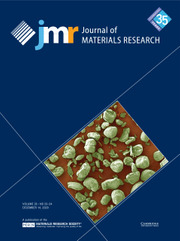Crossref Citations
This article has been cited by the following publications. This list is generated based on data provided by
Crossref.
Leff, A.C.
and
Taheri, M.L.
2016.
Quantitative assessment of the driving force for twin formation utilizing Nye tensor dislocation density mapping.
Scripta Materialia,
Vol. 121,
Issue. ,
p.
14.
Briggs, Samuel A.
Barr, Christopher M.
Pakarinen, Janne
Mamivand, Mahmood
Hattar, Khalid
Morgan, Dane D.
Taheri, Mitra
and
Sridharan, Kumar
2016.
Observations of defect structure evolution in proton and Ni ion irradiated Ni-Cr binary alloys.
Journal of Nuclear Materials,
Vol. 479,
Issue. ,
p.
48.
El-Atwani, O.
Nathaniel, J. E.
Leff, A. C.
Hattar, K.
and
Taheri, M. L.
2017.
Direct Observation of Sink-Dependent Defect Evolution in Nanocrystalline Iron under Irradiation.
Scientific Reports,
Vol. 7,
Issue. 1,
El-Atwani, O.
Nathaniel, J.E.
Leff, A.C.
Muntifering, B.R.
Baldwin, J.K.
Hattar, K.
and
Taheri, M.L.
2017.
The role of grain size in He bubble formation: Implications for swelling resistance.
Journal of Nuclear Materials,
Vol. 484,
Issue. ,
p.
236.
Bazarbayev, Yerik
Kattoura, Micheal
Mao, Keyou S.
Song, Jie
Vasudevan, Vijay K.
and
Wharry, Janelle P.
2018.
Effects of corrosion-inhibiting surface treatments on irradiated microstructure development in Ni-base alloy 718.
Journal of Nuclear Materials,
Vol. 512,
Issue. ,
p.
276.
Barr, Christopher M.
Felfer, Peter J.
Cole, James I.
and
Taheri, Mitra L.
2018.
Observation of oscillatory radiation induced segregation profiles at grain boundaries in neutron irradiated 316 stainless steel using atom probe tomography.
Journal of Nuclear Materials,
Vol. 504,
Issue. ,
p.
181.
Barr, Christopher M.
Nathaniel, James E.
Unocic, Kinga A.
Liu, Junpeng
Zhang, Yong
Wang, Yongqiang
and
Taheri, Mitra L.
2018.
Exploring radiation induced segregation mechanisms at grain boundaries in equiatomic CoCrFeNiMn high entropy alloy under heavy ion irradiation.
Scripta Materialia,
Vol. 156,
Issue. ,
p.
80.
Arora, Gaurav
Rawat, Kanishk D.
and
Aidhy, Dilpuneet S.
2018.
Effect of atomic order/disorder on Cr segregation in Ni-Fe alloys.
Journal of Applied Physics,
Vol. 124,
Issue. 11,
O’Brien, C. J.
Barr, C. M.
Price, P. M.
Hattar, K.
and
Foiles, S. M.
2018.
Grain boundary phase transformations in PtAu and relevance to thermal stabilization of bulk nanocrystalline metals.
Journal of Materials Science,
Vol. 53,
Issue. 4,
p.
2911.
Tawfeeq, Maisaa N.
and
Klassen, Robert J.
2019.
Effect of ion implantation on the grain boundary strength of heat treated Inconel X750.
Journal of Nuclear Materials,
Vol. 516,
Issue. ,
p.
255.
Meric de Bellefon, G.
Robertson, I.M.
Allen, T.R.
van Duysen, J.-C.
and
Sridharan, K.
2019.
Radiation-resistant nanotwinned austenitic stainless steel.
Scripta Materialia,
Vol. 159,
Issue. ,
p.
123.
Barr, Christopher M.
El-Atwani, Osman
Kaoumi, Djamel
and
Hattar, Khalid
2019.
Interplay Between Grain Boundaries and Radiation Damage.
JOM,
Vol. 71,
Issue. 4,
p.
1233.
Mao, Pengyan
Cui, Jingping
Chen, Yangchun
Qiu, Jianhang
Jin, Qun
Qiao, Jixiang
Zhao, Yang
Cui, Kan
Gao, Ning
and
Tai, Kaiping
2019.
Quantitative investigation on sink strength of nano-grain boundary for irradiation resistance.
Journal of Nuclear Materials,
Vol. 526,
Issue. ,
p.
151741.
Leff, A.C.
Runnels, B.
Nye, A.
Beyerlein, I.J.
and
Taheri, M.L.
2019.
Determination of minimal energy facet structures in Σ3 and Σ9 grain boundaries: Experiment and simulation.
Materialia,
Vol. 5,
Issue. ,
p.
100221.
Kuleshova, E.A.
Fedotova, S.V.
Gurovich, B.A.
Frolov, A.S.
Maltsev, D.A.
Stepanov, N.V.
Margolin, B.Z.
Minkin, A.J.
and
Sorokin, A.A.
2020.
Microstructure degradation of austenitic stainless steels after 45 years of operation as VVER-440 reactor internals.
Journal of Nuclear Materials,
Vol. 533,
Issue. ,
p.
152124.
Was, Gary S.
and
Zinkle, Steven J.
2020.
Comprehensive Nuclear Materials.
p.
468.
Zimber, N.
Vladimirov, P.
Klimenkov, M.
and
Kuksenko, V.
2020.
Investigation of a high-dose irradiated beryllium microstructure.
Journal of Nuclear Materials,
Vol. 540,
Issue. ,
p.
152374.
Kuleshova, E. A.
Fedotova, S. V.
Gurovich, B. A.
Frolov, A. S.
Maltsev, D. A.
Margolin, B. Z.
Minkin, A. J.
and
Sorokin, A. A.
2020.
Investigation of irradiated metal of WWER-type reactor internals after 45 years of operation. Part 3. Microstructure and phase composition.
Voprosy Materialovedeniya,
p.
157.
Nathaniel, James E.
Vetterick, Gregory A.
El-Atwani, Osman
Leff, Asher
Baldwin, Jon Kevin
Baldo, Pete
Kirk, Marquis A.
Hattar, Khalid
and
Taheri, Mitra L.
2021.
The influence of solute on irradiation damage evolution in nanocrystalline thin-films.
Journal of Nuclear Materials,
Vol. 543,
Issue. ,
p.
152616.
Zhang, Y.
Jiang, W.Q.
Gokhman, A.
Yang, J.J.
Shi, K.
Luan, J.H.
Cui, Y.
Liaw, Peter K
Liu, C.T.
and
Zhang, Z.W.
2021.
Enhanced irradiation tolerance of Fe30Cr25Ni20Co15Mn10 high-entropy alloy via nanotwin boundaries.
Journal of Nuclear Materials,
Vol. 557,
Issue. ,
p.
153292.



